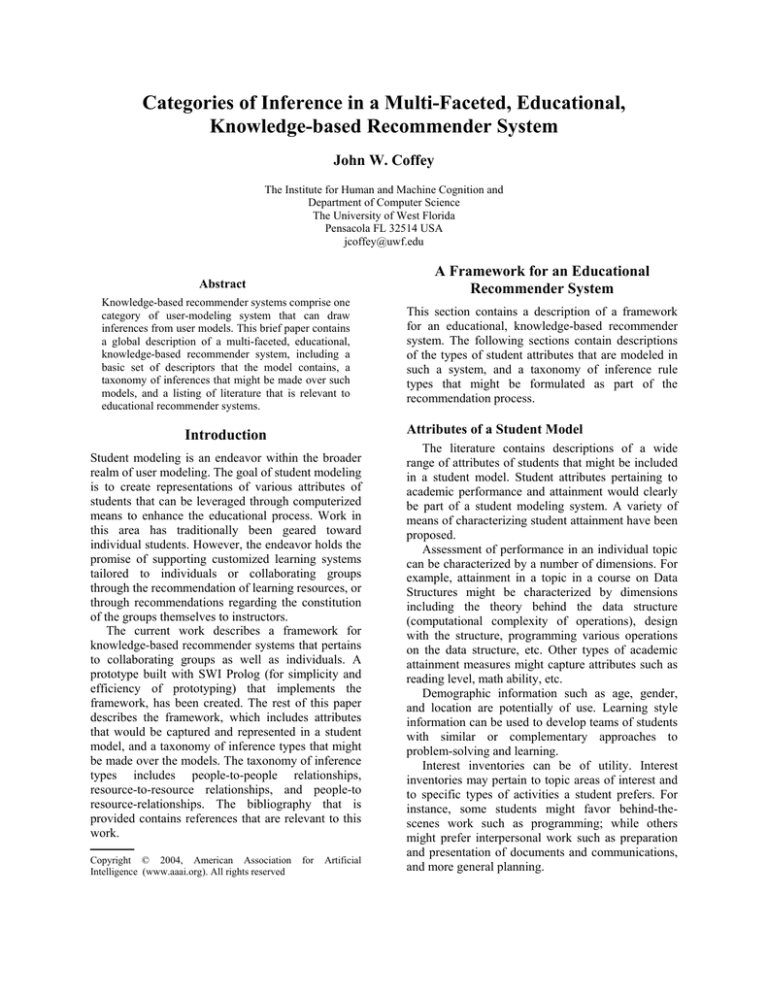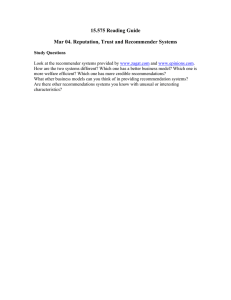
Categories of Inference in a Multi-Faceted, Educational,
Knowledge-based Recommender System
John W. Coffey
The Institute for Human and Machine Cognition and
Department of Computer Science
The University of West Florida
Pensacola FL 32514 USA
jcoffey@uwf.edu
Abstract
Knowledge-based recommender systems comprise one
category of user-modeling system that can draw
inferences from user models. This brief paper contains
a global description of a multi-faceted, educational,
knowledge-based recommender system, including a
basic set of descriptors that the model contains, a
taxonomy of inferences that might be made over such
models, and a listing of literature that is relevant to
educational recommender systems.
This section contains a description of a framework
for an educational, knowledge-based recommender
system. The following sections contain descriptions
of the types of student attributes that are modeled in
such a system, and a taxonomy of inference rule
types that might be formulated as part of the
recommendation process.
Attributes of a Student Model
Introduction
Student modeling is an endeavor within the broader
realm of user modeling. The goal of student modeling
is to create representations of various attributes of
students that can be leveraged through computerized
means to enhance the educational process. Work in
this area has traditionally been geared toward
individual students. However, the endeavor holds the
promise of supporting customized learning systems
tailored to individuals or collaborating groups
through the recommendation of learning resources, or
through recommendations regarding the constitution
of the groups themselves to instructors.
The current work describes a framework for
knowledge-based recommender systems that pertains
to collaborating groups as well as individuals. A
prototype built with SWI Prolog (for simplicity and
efficiency of prototyping) that implements the
framework, has been created. The rest of this paper
describes the framework, which includes attributes
that would be captured and represented in a student
model, and a taxonomy of inference types that might
be made over the models. The taxonomy of inference
types includes people-to-people relationships,
resource-to-resource relationships, and people-to
resource-relationships. The bibliography that is
provided contains references that are relevant to this
work.
Copyright © 2004, American Association
Intelligence (www.aaai.org). All rights reserved
A Framework for an Educational
Recommender System
for
Artificial
The literature contains descriptions of a wide
range of attributes of students that might be included
in a student model. Student attributes pertaining to
academic performance and attainment would clearly
be part of a student modeling system. A variety of
means of characterizing student attainment have been
proposed.
Assessment of performance in an individual topic
can be characterized by a number of dimensions. For
example, attainment in a topic in a course on Data
Structures might be characterized by dimensions
including the theory behind the data structure
(computational complexity of operations), design
with the structure, programming various operations
on the data structure, etc. Other types of academic
attainment measures might capture attributes such as
reading level, math ability, etc.
Demographic information such as age, gender,
and location are potentially of use. Learning style
information can be used to develop teams of students
with similar or complementary approaches to
problem-solving and learning.
Interest inventories can be of utility. Interest
inventories may pertain to topic areas of interest and
to specific types of activities a student prefers. For
instance, some students might favor behind-thescenes work such as programming; while others
might prefer interpersonal work such as preparation
and presentation of documents and communications,
and more general planning.
A Taxonomy of Inference Categories
Inference over student models can be in service of a
variety of goals. The proposed framework is
comprised of three general categories of inference:
• People-to-people
• Resource-to-resource
• People-to-resource
People-to-people queries are used by students
themselves in order to identify potential
collaborators, or by instructors to form collaborating
groups. Resource-to-resource queries are used to
assemble packages of resources to address specific
learning objectives. People-to-resource queries are
used to match collaborating teams to resource
packages.
Resource-to-resource queries utilize attributes of
resources in order to build aggregations of resources
directed toward an individual or group. Basic
attributes of resources include content area (to what
topic or topics does the resource pertain?), the basic
type of document: theoretical, applied, case study,
etc., intended audience: introductory, intermediate or
advanced, reading level, and chronology of document
formation (to address the evolution of thought in the
area). Descriptors are used to create sequences of
resources, for instance suggesting that a theoretical
description be viewed first, followed by a simple case
study that makes sense within the context of the
theory, and then a more complex case study that
requires generalization of the theory.
People-to-resource queries identify interest or
remediation items for the individuals or for groups
that are identified in the people-to-people results. The
goal is to build tailored packages of resources that
might be of utility to the individual or group.
Conclusions
This work describes a basic, global framework for
student modeling in service of an educational,
knowledge-based recommender system. One of the
main motivations for this work is the anticipation of
the sorts of inferences that might be performed in
courses offered at a distance, utilizing multi-faceted
models of students and semantically characterized
resources.
It seems clear that the ability of instructors to gain
a better understanding of their students would be
particularly valuable in distance learning settings.
Although this brief description of the current work
does not afford room for examples of queries that
have been formulated, it is worth noting that the rules
form triples that are easily converted into a
representation such as RDF. Implementation of this
framework in the context of a learning management
system for Web-based course offerings holds
potential to address many deficiencies of current
distance-learning environments. The combination of
multi-faceted student models with the Semantic Web
holds the promise to usher in a new era in distance
learning environments.
Relevant Literature
Barker, T., Jones, S., Britton, C., and Messer, D.
2002. The Use of Co-operative Student Model of
Learner Characteristics to Configure a Multimedia
Application. User Modeling and User-Adapted
Interaction. 12:207-241.
Bianchi-Berthouze, N., and Lisetti, C.L. 2002.
Modeling Multimodal Expression of User's Affective
Subjective Experience. User Modeling and UserAdapted Interaction. 12:49-84,
Brusilovsky, P. 1996. Methods and Techniques of
Adaptive Hypermedia In P. Brusilovsky and J.
Vassileva, eds. User Modeling and User-Adapted
Interaction. Special issue on Adaptive Hypertext and
Hypermedia. 6(2-3):87-129.
Bull, S. Brna, P., and Pain, H. 1995. Extending the
Scope of the Student Model. User Modeling and
User-adapted Interaction. 5(1): 45-65.
Burke, R. 2002. Hybrid recommender systems:
Survey and Experiments. User Modeling and UserAdapted Interaction. 12:331-370.
Calvi, L., and Cristea, A. 2002. Towards Generic
Adaptive Systems: Analysis of a Case Study. Lecture
Notes in Computer Science, vol. 2347: De Bra, P.;
Brusilovsky, P.; Conejo, R., eds. Springer-Verlag.
Conlan, O., Wade, V., Bruen, C., and Gargan, M.
2002. Multi-model, Metadata Driven Approach to
Adaptive Hypermedia Services for Personalized ELearning, Lecture Notes in Computer Science, vol.
2347: De Bra, P.; Brusilovsky, P.; Conejo, R., eds.
Springer-Verlag.
De Bra, P., and Ruiter, J. 2002. AHA! Adaptive
Hypermedia for All. Proceedings of WebNet 2001,
World Conference on the WWW and Internet.
October 23-27, 2001, Orlando, FL. 262-268.
Finin, T., and Drager, D. 1986. GUMS: A General
User Modeling System. In Proceedings of the 1986
Canadian Society for Computational Studies of
Intelligence (CSCSI-86). 24-30. Montreal, Canada,
May 21-23.
Kurhila, J., Miettinen, M., Nokelaimen, P., and Tirri,
H. 2002. EDUCO - A Collaborative Learning
Environment Based on Social Navigation. Lecture
Notes in Computer Science, vol. 2347: De Bra, P.;
Brusilovsky, P.; Conejo, R., eds. Springer-Verlag.
Rich, E. 1979. User Modeling via Stereotypes.
Cognitive Science 3:329-354.


